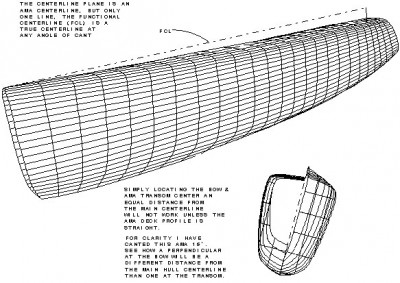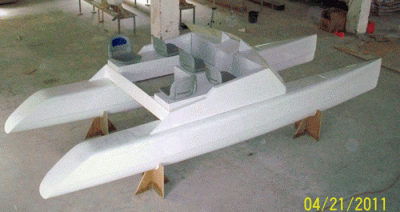I had a visit today from the builder of the stretched 63 trimaran in Marysville. It will have two unstayed rotating carbon masts. He is a prodigious worker. This picture is from a couple of years ago.
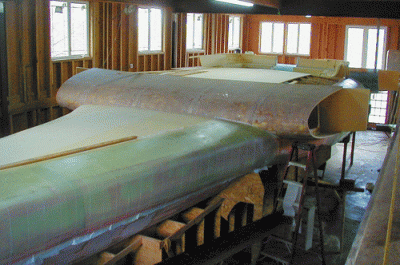
Fiberlay Seminar
BASIC COMPOSITE & MOLD MAKING TRAINING CLASSES
Saturday, May 7th 2011
9am – 3pm
Fiberlay – Seattle
24 South Idaho Street, Seattle WA 98134
$50 per person
(lunch included)
Call for David Chamberlain for details 206-782-0660 or
Email: david@fiberlay.com
SCHEDULE
9am – 10am
Mold Making with Polyurethanes, Silicones & other
10am – 10:15am
Break
10:15am – 1pm
General Composite Materials, Equipment & Infusion Process
1pm
Lunch
1 – 3pm
Questions, Retail Open to Class
New Picture of 21 Motor Cat in China
KHSD Multihulls in Puget Sound/Seattle
Conventional wisdom is that as soon as a multi is built here, it sails for warmer climates. Or that they are all store-bought F-boats that have been capsized at least once.
Actually there are a surprising number of KHSD multihulls building and sailing in this area. None have capsized so far, and the owners are not clubbie so they are not on club memberships. In no particular order, and I must have forgotten several, and I know I’m forgetting a bundle of little daysailors:
49′ cat – Poulsbo
Formula 40 tri- Seattle, for now
45′ cat – Bellingham
45′ cat – Seattle
63’/65′ trimaran – Marysville
56′ cat – Port Angeles
56′ cat – Portland,OR
Chaak 49′ tri – Seattle
Proa 26′ – San Juans
Proa 24′ – Seattle
26′ tri – Bellingham
36′ daycharter cat – Blaine
37′ tri – Seattle
52′ tri – eastside, may not still be on
37′ tri – Bellingham
40′ tri – Bellingham or farther
65′ catamaran ferry – Everett
31′ tri -Port Townsend
27 cat – Seattle
40′ powercat – Tri Cities, OK thats very greater Puget sound.
How about that? Who knew? Let me know if I have forgotten anyone.
Properties of Hat Sections
To get more room in a hull space people often want to substitute a hat section layup for a bulkhead. So how do they compare structurally?
First, ABS ORY tells me that I can use some of the hull skin in the laminate calculations. But only a flange width of 18 times the skin thickness, plus the base width of the internal part. The skin thickness is assumed to be 0.15″.
The basic bulkhead is assumed to be an inch wide so I’m allowed to use about 4″ of the flange width. I will assume the bulkhead is 6″ tall and has 0.1″ laminate faces.
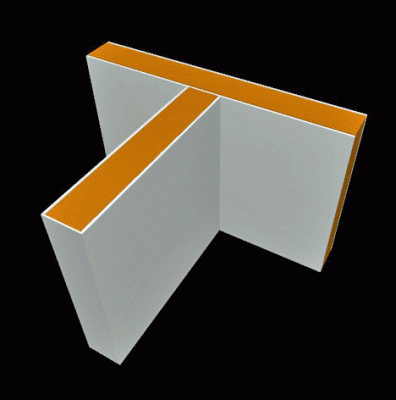
For a hat section I assume that base is about 6″. I’ll again use a skin thickness of 0.15″, giving me about 3″ so a total flange width of 9″. I give it a 3″ wide inside flange and sides at 45 degrees. Those parts are also 0.1″ thick. I assume all parts are of equal strength.
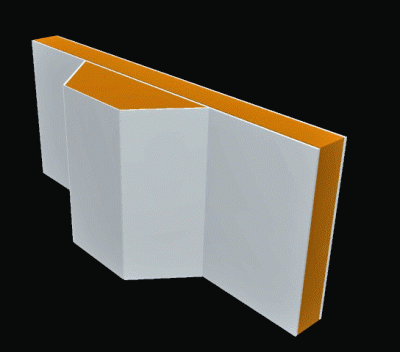
The original bulkhead gave a section modulus SM of 2.1 inches to the third power (2.1 in^3).
The hat section only gives SM of 1.33 in^3. If I thicken all the hat parts to 0.13″ (4 times 17 oz biaxial) it still only gives a SM of 1.6 in^3. 5 layers of biaxial will give a SM of 2 in^3.
Conclusion. Like magical catamaran beams, hat sections take more material to achieve the same strength as a bulkhead.
Builder in Goa
I finally got the slightly dated web address of the KHSD builder in Goa, India. Contact at www.multitechmarine.com
I’m beginning work on their passenger power trimaran next week.
JR Tomorrow Morning
I don’t know why it took me so long to realize this information should be here on the blog. It just might have been the extra oxygen from the bike ride just finished.
Tomorrow A19th at 8:30 in the morning Pacific time JR Watson will be on ProBoat Radio. He not only knows all about epoxy, but this will honor his long career with Gougeon Bros.
http://proboatradio.com/2011/04/14/glue-and-you/
Thoughts on the African Catamaran
As I was laminating the lunar lander bits on Tuesday, I got some perspective on the Earthwise ferry. I often take amazing things for granted, and I have done so with this. What Rob Smith has put together is really amazing. My 25 years of doing plywood/epoxy passenger cats were just what he needed for this venture. He knew just where my skill set would fit in to the big picture. And more than a boat, he has organized the entire venture where they will be built there in Africa with local materials. Showboats magazine has featured a mega-yacht with bamboo flooring and called it “sustainable”. This is the real sustainable deal. It will be positively changing the lives of thousands of people. I’m surprised that Wooden Boat or even Pro Boat are not all over this. This is not 17′ lapstrake canoes for dilettantes. This is plywood/epoxy/core fusion creating big positive change.
I did try to interest Workboat in this a year or so ago. They were so disinterested. “If its not a tin boat built in Houma by a guy named Skeeter, keep moving.” was the sense I got. It’s humbling to be part of this.
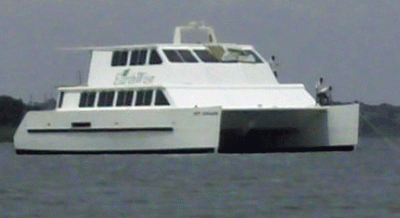
Elderly CM Hulls – How They Hold Up
Uber surveyor Dennis Smith got to run survey on a couple of 25 year old KHSD CM multihulls. Both had minor rot places. Both spots were inside the hulls at remote locations where epoxy was skimped. The trouble is inside, not the outside. The take-away lesson is coat inside thoughly and make sure any damage is repaired. Cove all the joints. Epoxy hulls still need to be ventilated. Note they were both the $6 door skins and not the 6566 that we use now. But coat it good inside!
Trimaran Hull Alignment
On a catamaran, you simply measure centerline to centerline front and back, and you’re there.
On a trimaran, if the amas have no angle, or if the sheer line is parallel to the water, the same.
But who wants amas with no angle and no shape on the sheer? On these, if you match centerline forward with centerline aft, your hulls will not be parallel. This slightly ancient graphic shows why. The CM Construction Manual has this and the new Composites Manual underway now will have a newer graphic of the same thing.
